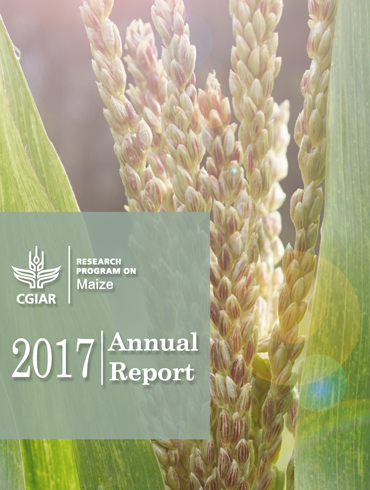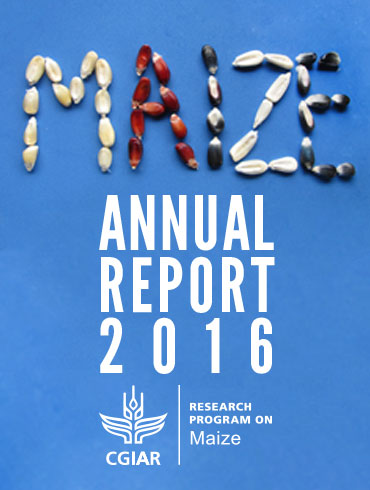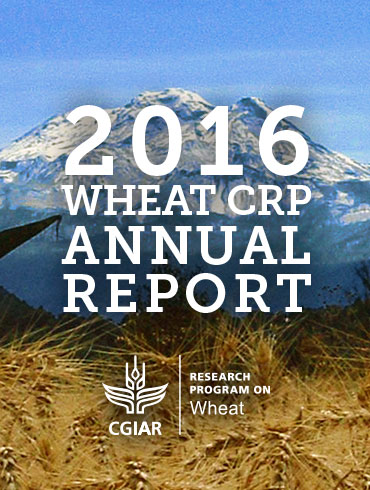CRP Maize Annual Report 2021
The newly released CGIAR Research Program on Maize 2021 Technical Annual Report highlights joint achievements in making maize more affordable, nutritious and available for consumers and producers worldwide.
The newly released CGIAR Research Program on Maize 2021 Technical Annual Report highlights joint achievements in making maize more affordable, nutritious and available for consumers and producers worldwide.
The newly released CGIAR Research Program on Wheat 2021 Technical Annual Report highlights joint achievements in making wheat more affordable, nutritious and available for consumers and producers worldwide.
Over the course of ten years, WHEAT worked with hundreds of research and development partners worldwide to release high-yielding, disease-resistant, nutritious and climate-resilient wheat varieties, and efficient, sustainable wheat-based cropping systems.
This final report from 2021 shares important research on staple cereals’ role in global efforts towards food security, the number and distribution of wheat farms, the expected impact of climate change on wheat productivity, nitrogen-in-agriculture research, nutrition, and the most critical, immediate effects of COVID-19 on food systems, and more.
With its national partners, WHEAT released 70 new CGIAR-derived wheat varieties to farmers in 13 countries in 2021, and developed 18 innovations in the areas of genetics, biophysics, farm management, research and communication methods, or social sciences.
The CGIAR Research Program on Maize (MAIZE) is proud to release its 2020 Annual Report.
Read the 2020 MAIZE Annual Report
In 2020, faced with the extraordinary challenges posed by the COVID-19 pandemic, MAIZE continued its mission to strengthen maize-based agri-food systems while improving the food security and livelihoods of the most vulnerable, especially resource-constrained smallholder farmers and their families.
MAIZE and its partners made great advances in the development of improved stress-tolerant maize varieties, the battle against fall armyworm (including the announcement of three first-generation fall armyworm-tolerant maize hybrids), testing and promoting of conservation agriculture and sustainable intensification, and in deepening our grasp of how to best empower women in the quest for gender equality and social inclusion in maize-based agri-food systems.
Led by the International Maize and Wheat Improvement Center (CIMMYT), with the International Institute of Tropical Agriculture (IITA) as its main CGIAR Consortium partner, MAIZE focuses on increasing maize production for the 900 million poor consumers for whom maize is a staple food in Africa, South Asia and Latin America.
We are proud to present highlighted impacts from WHEAT’s research in our 2020 Annual Report, showcasing the shared accomplishments through global partnerships for the eighth year of the program.
Read a PDF version of the WHEAT 2020 Annual Report
Read the WHEAT 2020 Technical Annual Report
In 2020, the COVID-19 crisis devastated communities, economies, and livelihoods, especially of the world’s most vulnerable populations. At the same time, climate change continued to threaten wheat systems around the world. Under unprecedented challenges, WHEAT scientists and partners responded swiftly, generating new research evidence, forming new partnerships, and improving access to conservation agriculture and farm mechanization technologies.
This web-based report focuses on some of the major impacts the program has had on sustainable intensification, gender and social inclusion, and technological innovations for more productive wheat-based farming. Although they are reported for 2020, these impacts reflect years of dedicated science and strong collaborative relationships with partners.
We are deeply grateful for our partners in the science, research, policymaking, and funding communities who have allowed us to continue our work in the face of urgent and powerful challenges. We hope you enjoy this year’s Annual Report as we look back upon our outcomes and achievements in 2020 and set our targets for the future.
The CGIAR Research Program on Maize (MAIZE) is proud to release its 2019 Annual Report.
Around the world, the COVID-19 crisis has emphasized the need to strengthen food systems while improving the food security and livelihoods for the most vulnerable, especially the resource-constrained smallholder farmers.
In 2019 MAIZE and its partners made great advances in the development of improved stress-tolerant maize varieties, continued their battle against fall armyworm in both Africa and Asia, and maintained their focus on sustainable intensification of maize-based cropping systems in sub-Saharan Africa, South Asia and Latin America where maize plays a critical role in food and nutritional security, income and livelihoods of millions of resource-constrained smallholders and consumers. We look forward to continued productive collaborations as we transition with our partners into an integrated, inclusive One CGIAR designed to meet the UN Sustainable Development Goals.
Led by the International Maize and Wheat Improvement Center (CIMMYT), with the International Institute of Tropical Agriculture (IITA) as its main CGIAR Consortium partner, MAIZE focuses on increasing maize production for the 900 million poor consumers for whom maize is a staple food in Africa, South Asia and Latin America.
The CGIAR Research Program on Wheat (WHEAT) is proud to release its 2019 Annual Report, celebrating shared achievements through partnerships around the world for the seventh year of the program.
In this year’s report, we highlight cutting-edge work by researchers and partners — particularly our primary research partner, the International Center for Agricultural Research in the Dry Areas (ICARDA) — to help farmers grow wheat that is nutritious, resilient, and high-yielding, while decreasing environmental impact.
DNA fingerprinting, a smartphone-powered warning system, no-till innovations and the joint release of 50 new CGIAR-derived wheat varieties are just a few markers of success in a busy, challenging, and exciting year.
The threat of the current global pandemic highlights the crucial role wheat plays in the health and livelihoods of millions. We look forward to continued productive collaborations as we transition with our partners into an integrated, inclusive One CGIAR designed to meet the UN Sustainable Development Goals.
Read the WHEAT Annual Report 2019
The newly released CGIAR Research Program on Maize (MAIZE) Annual Report 2018 highlights significant development outcomes and impacts through varietal release, scale-up, delivery and adoption of CIMMYT- and IITA-derived climate-resilient and nutritionally enriched maize varieties.
In 2018, national partners released 81 unique CGIAR-derived maize varieties across Africa, Asia and Latin America. Of these varieties 14 were hybrid combinations, showing that regional and multinational seed companies use MAIZE’s improved germplasm to develop and release improved maize hybrids. 20 of the released varieties are nutritionally enriched — provitamin A, quality protein maize (QPM), high-zinc — the result of the MAIZE partnership with the CGIAR Research Program on Agriculture for Nutrition and Health (A4NH; HarvestPlus).
MAIZE and partners have made great strides in 2018 combatting major pest and disease challenges such as maize lethal necrosis (MLN) and the devastating fall armyworm. MAIZE researchers found that sustainable intensification practices in combination with stress-tolerant maize led to higher yield gains during the El Niño year in Southern Africa. Meanwhile, a crop growth modelling study quantified the impact of climate change on maize and found combined drought and heat stress tolerance has a benefit at least twice that of either one alone.
The newly released CGIAR Research Program on Wheat (WHEAT) Annual Report 2018 highlights joint achievements that are making an invaluable contribution to global food security, especially for the 2.5 billion people who depend on wheat for their livelihoods.
The report describes work with national and global partners using state of the art technology to measure traits and performance for faster development of high-yielding, heat- and drought-tolerant varieties; rapidly diagnosing diseases in farmers’ fields; supporting gender equality in agricultural innovations, and much more.
With its national partners, WHEAT released 48 new CGIAR-derived wheat varieties to farmers in 2018, and developed 11 innovations related to farm management practices or social sciences.
 In 2017, 79 improved maize varieties were released by the CRP MAIZE partners worldwide, including 26 in Latin America, 44 in Sub-Saharan Africa and 9 in Asia. These varieties are based on use of CGIAR lines from CIMMYT and the International Institute of Tropical Agriculture (IITA). Some of the special traits stacked in these varieties include drought and heat tolerance, nitrogen use efficiency, enhanced protein quality, high kernel zinc and resistance to diseases of regional or global importance, such as maize lethal necrosis (MLN), tar spot complex (TSC), and resistance to the parasitic weed, Striga. MAIZE worked with partners to control the spread of Fall Armyworm in Africa.
In 2017, 79 improved maize varieties were released by the CRP MAIZE partners worldwide, including 26 in Latin America, 44 in Sub-Saharan Africa and 9 in Asia. These varieties are based on use of CGIAR lines from CIMMYT and the International Institute of Tropical Agriculture (IITA). Some of the special traits stacked in these varieties include drought and heat tolerance, nitrogen use efficiency, enhanced protein quality, high kernel zinc and resistance to diseases of regional or global importance, such as maize lethal necrosis (MLN), tar spot complex (TSC), and resistance to the parasitic weed, Striga. MAIZE worked with partners to control the spread of Fall Armyworm in Africa.
In 2017, WHEAT and its partners gained ground on research to develop stress-tolerant wheat varieties and promote complimentary sustainable intensification practices to increase wheat yields in all major target areas.
Read the full report in PDF format
 In 2016, the CGIAR Research Program on Maize (MAIZE) made strong progress on both of its research strategies, stress resilient and nutritious maize, and sustainable intensification of maize-based systems. In total, 111 improved maize varieties based on germplasm from MAIZE lead centers, CIMMYT and the International Institute of Tropical Agriculture (IITA), were released through MAIZE partners in 2016.
In 2016, the CGIAR Research Program on Maize (MAIZE) made strong progress on both of its research strategies, stress resilient and nutritious maize, and sustainable intensification of maize-based systems. In total, 111 improved maize varieties based on germplasm from MAIZE lead centers, CIMMYT and the International Institute of Tropical Agriculture (IITA), were released through MAIZE partners in 2016.
 For 2017, WHEAT research outcomes benefited the poorest in remote areas in Afghanistan to get access to quality seed through collaboration with national research partners. In Ethiopia – emergency seed supply – as well as in India’s Bihar state and in Pakistan ensured food security for farmers who depend on the crop.
For 2017, WHEAT research outcomes benefited the poorest in remote areas in Afghanistan to get access to quality seed through collaboration with national research partners. In Ethiopia – emergency seed supply – as well as in India’s Bihar state and in Pakistan ensured food security for farmers who depend on the crop.